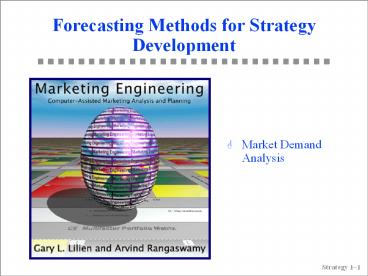Forecasting Methods for Strategy Development - PowerPoint PPT Presentation
1 / 22
Title:
Forecasting Methods for Strategy Development
Description:
Forecasting Methods for Strategy Development Market Demand Analysis – PowerPoint PPT presentation
Number of Views:187
Avg rating:3.0/5.0
Title: Forecasting Methods for Strategy Development
1
Forecasting Methods for Strategy Development
- Market Demand Analysis
2
Quote for the Day
- There are two kinds of forecasters. Those who
dont know and those who dont know that they
dont know. - - John Kenneth Galbraith
3
Two Kinds of Forecasts
- Passive forecasts (assumes demand exists and we
simply measure it). Can help us determine when
to allocate strategic resources. - e.g., time series methods
- Active forecasts (assumes we can influence demand
through marketing efforts). Can help us
determine when, where, and how much of
strategic resources to invest. - e.g., causal analysis
4
Forecasting Methods
- Market Judgmental Survey Time
Causal Methods Series Analyses - Salesforce Buyer Naive methods Regression
analysis composite intentions Moving
averages Econometric modelsJury of
executive Product tests Exponential Input-output
opinion smoothing analysisDelphi
methods Box-Jenkins MARMA method Neural
networks Decompositional MNL analysis methods
5
Three Methods We Will Use
- Regression
- Multinomial (and Binary) Logit Analysis
- Neural Networks
6
MNL Model for Response to Direct Mail
- Probability of function of (past response
bahavior, - responding to marketing effort,
- direct mail characteristics of
- solicitation customers)
7
Individual-Level MNL Models
- Multinomial logit model to represent probability
of choice. Individual is probability of
choosing brand 1 is - eAi1
- Pi1
- å eAij
- j
- where Aij å wk bijk
- k
- Aij is the attractiveness of alternative j, and
is a linear composite of selected - variables (bijk) that vary by brand (j) and
individual (i).
8
Variables used in Bookbinders Case
- Amount purchased in the past
- Frequency of purchase
- Last purchase
- First purchase
- Number of childrens books purchased
- Number of youth books purchased
- Number of cookbooks purchased
- Number of DIY books purchased
- Number of art books purchased
9
Model Estimation
- Dependent variable is choice - whether someone
purchased/selected a product on a purchase
occasion (i.e., variable is 0 or 1). - Estimation is by maximum likelihood methods.
10
Artificial Neural Networks for Modeling Market
Response
- What is a neural network?
- Determinants of network properties
- Description of feed-forward network with back
propagation - Potential value of neural networks
11
What Is An Artificial Neural Network?
- An artificial neural network is a general
response model that relates inputs (e.g.,
advertising) to outputs (e.g., product
awareness). - A neural net attempts to mimic how the human
brain processes input information and consists of
a richly interlinked set of simple processing
mechanisms (nodes).
12
Characteristics of Biological Neural Networks
- Massively parallel
- Distributed representation and computation
- Learning ability
- Generalization ability
- Adaptivity
- Inherent contextual information
- Fault tolerance
- Low energy consumption
13
Artificial Neural Network
Neurons
Inputs In humanssensory data. In
4Thoughtadvertising, selling effort, price, etc.
Outputs In humansmuscular reflexes. In
4Thoughtsales model.
Synapses
14
Determinants of the Behavior of Artificial Neural
Network
- Network properties (depends on whether network is
feedforward or feedback number of nodes, number
of layers in the network, and order of
connections between nodes). - Node properties (threshold, activation range,
transfer function). - System dynamics (initial weights, learning rule).
15
Processing Mechanism of Individual Neurons
- Convert input signals into overall signal value.
- Z å Wi Xi
- i
- Transform overall signal value into output signal
(transfer function).
16
Transfer Function Formulations
- Hard limiter (Y 1 if Z T else 0)
- Sigmoidal (0 Y 1)
- 1
- Y g(Z)
- 1 e(ZT)
- Tanh (1 Y 1)
- Y g(Z) tanh (Z T)
17
System Dynamics(Learning Mechanism)
- Supervised learning using back propagation of
errors. Goal of this process is to reduce the
total error at output nodes - EP å (tPk OPk)2
- k
- where
- EP error to be minimized
- tPk target value associated with the kth
input values - OPk Output of neural net as calculated from
current set of weights.
18
Error Propagation
- The error is calculated at each node for each
input set k - The error at the output node is equal to
- diL g (ZiL)tiL YiL
- where
- TiL Target value on the i-th output node
(layer L of network) - diL Error to be back propagated from node i
in layer L - g gradient of transfer function.
19
Error Propagation
- Error is propagated back as follows
- dil g (Zil) å wijl1 djl1
- j
- for l (L1), . . . 1.
- The weights are then adjusted using an
optimality rule (in conjunction with a learning
rate) to minimize overall error EP.
20
So, Whats the Big Deal?
- With a sigmoidal transfer function and back
propagation, the neural network can learn to
represent any sampled function to any required
degree of accuracy with a sufficient number of
nodes and hidden layers. - This allows us to capture underlying
relationships without knowing the form of the
relationship.
21
Some Successful Applications
- Recognizing handwritten characters (zip codes)
- Recognizing speech
- Estimating response to direct mail operations
22
Choosing a Forecasting Method
Objective data available?
Judgmental method
No
Yes
New product situation?
New product methods (ch. 7)
Yes
No
Large changes in environment?
Extrapolation/Time Series methods
No
Yes
No
Good information on relationships?
Neural nets
No
Yes
No
Much data on causal variables?
Causal method
No
Yes
No
Major data problems?
Yes































